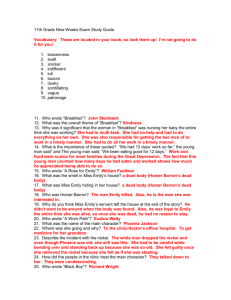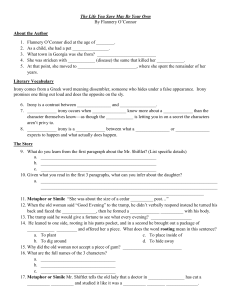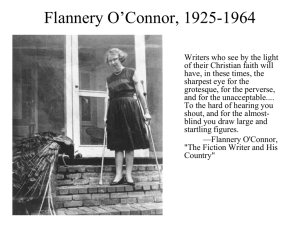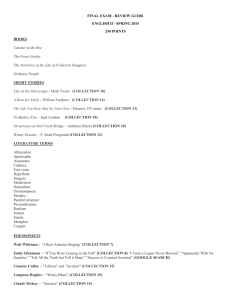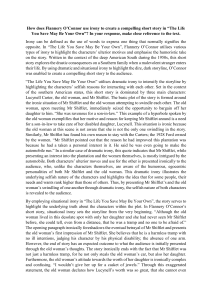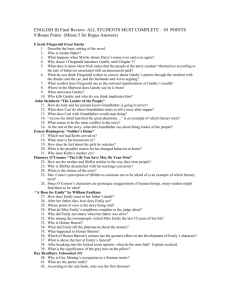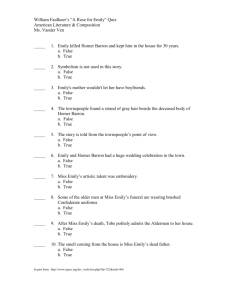“From Depression to Cold war” Unit VI Selection Notes
advertisement
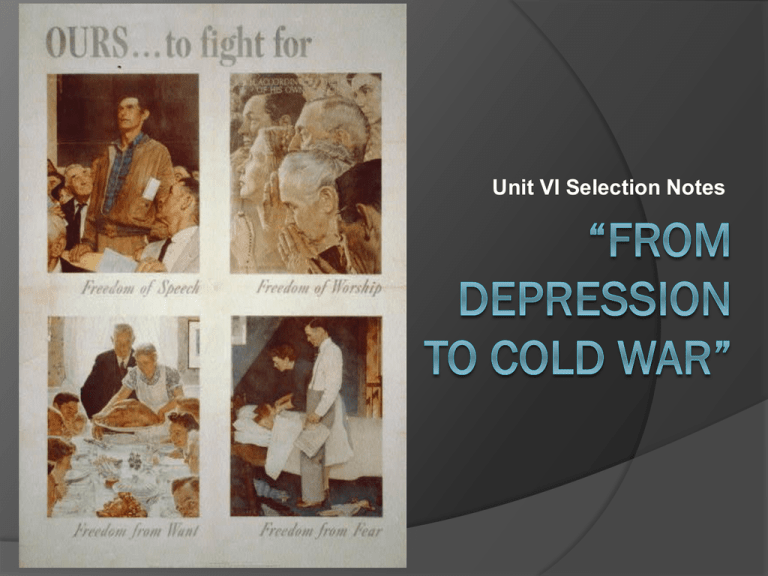
Unit VI Selection Notes “New Regionalism and the City” William Faulkner Style is fragmented narrative, lacking chronological order, using flashbacks Themes: South as a reflection of universal truths Insight into human emotions Man as a poor caretaker of the wilderness Family strength and traditions Racism Decay *Isolation *Disillusionment *Need for love and understanding (*Common to Modernism) “A Rose for Emily” Literary devices: foreshadowing, setting, tone, Southern Gothic Tale – a story with a remote, gloomy, decaying setting and involving supernatural and violent events Town in which story is set and time periodsocial mores/class consciousness/attitudes towards blacks, Northerners, and women of the town (Think about the citizens of Maycomb, Alabama, in To Kill a Mockingbird.) Tones/attitudes of citizens toward Emily: scorn, pity, curiosity, duty, acceptance, and horror Attitude of Emily toward town: condescending Her father’s behavior Emily’s reactions to father’s death and Homer’s rejection Events leading up to Emily and Homer’s apparent wedding Homer’s disappearance Significance of long strand of gray hair x Eudora Welty a writer and photographer who is interested in conveying true character in both genres “A Worn Path” Symbols The wornness of the path represents Phoenix’s enduring love. Phoenix’s name symbolizes her solitude, long life, and strength of character. The journey represents a difficult life. Phoenix – character description; attitudes towards hunter, doctor’s receptionist, etc. Theme: The path of love—worn by sacrifice and repetition—is open to everyone. x Flannery O’Connor Her style blends tragedy and comedy, presents realistic characters. “The Life You Save May Be Your Own” Literary devices: Foreshadowing-(setting/mood, Shiftlet’s name, his appearance described as “crooked” and “as a snake,” words like “rocked violently”) Suspense-mood of imminent danger Irony -Reversals of elements of a typical romance, such as the beautiful young woman and the rescuing hero -The “rotten” Shiftlet doesn’t recognize his contribution to “the rottenness of the world.”x Literary devices (continued): Epiphany-moment when main character makes a surprising discovery (often spiritual) Figures of Speech/Figurative language- Biblical images, character descriptions Dialect-part of characterization Themes-Most people are motivated by self-interest (title) -Innocence is only possible in modern society in extreme ignorance. x Review Shiftlet’s agreements with Mrs. Crater. Their terms? Motives? Both Shiftlet’s and Mrs. Crater’s characters are morally questionable. The hitchhiker rejects Shiftlet’s hypocritical pretense to care, his lies. The storm images at the end may warn that God’s wrath is closing in on Shiftlet. x Gwendolyn Brooks In her poems Brooks frequently includes characters based on African Americans she knew in Chicago, many of whom experienced disillusionment and poverty. x “The Bean Eaters” The old couple eats a simple meal of beans in a cluttered rented room and remembers the joys and sorrows they have experienced. The irregular rhyme scheme suggests the disorder of the couple’s life. “The United States and the World” Randall Jarrell a serviceman in WWI, Jarrell writes with both bitterness and pity about incidents of war that he witnessed. “The Death of the Ball Turret Gunner” The speaker has died in battle. The images and words which the poet chooses mingle together ideas of birth, sleep, and death. x Elie Wiesel For nine years this Holocaust survivor kept a vow of silence about the horrors of WWII. However, he later chose to write and speak about these painful experiences so that the world could not forget the Holocaust and so that his audiences realize that indifference and neutrality make room for exploitation of others. Excerpt from All Rivers Run to the Sea In this memoir Wiesel alternates between a description of his family’s deportation to the Auschwitz-Birkenau concentration camps and an account of his attempts as an adult to find answers to what happened to others and why the world could allow such horrors. John Hersey a foreign correspondent in the Pacific during WWII, Hersey is better known for his novels which so realistically portrayed individuals he knew during the war. Excerpt from Hiroshima Hersey provides a nonfiction account of the effects the atomic bomb had on the Japanese city of Hiroshima. In an objective tone he combines the stories of six ordinary people who survived the atomic blast and describes the extent of the devastation and suffering which the bombing caused. x
